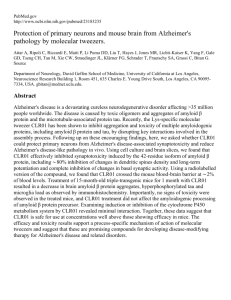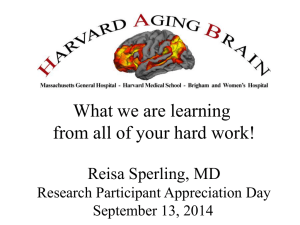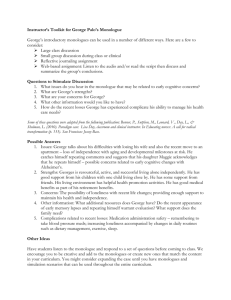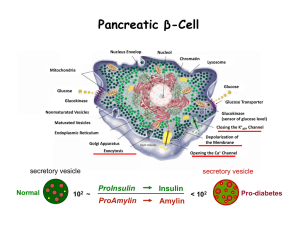C V Alzheimer’s and Related Diseases Research Award Fund
advertisement
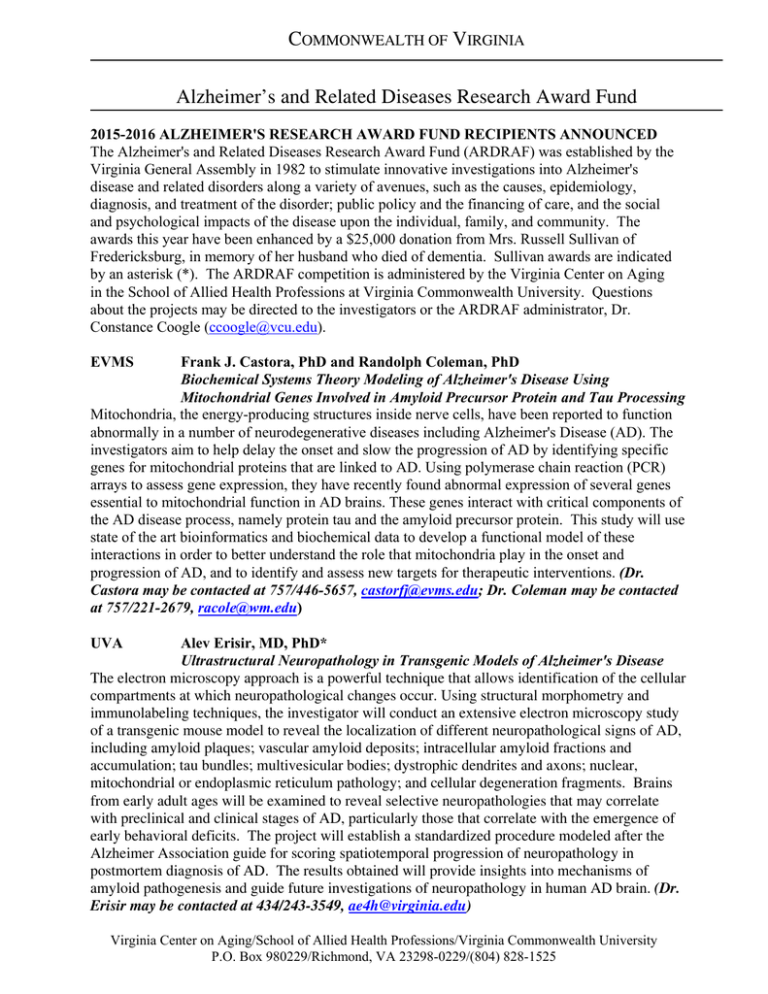
COMMONWEALTH OF VIRGINIA Alzheimer’s and Related Diseases Research Award Fund 2015-2016 ALZHEIMER'S RESEARCH AWARD FUND RECIPIENTS ANNOUNCED The Alzheimer's and Related Diseases Research Award Fund (ARDRAF) was established by the Virginia General Assembly in 1982 to stimulate innovative investigations into Alzheimer's disease and related disorders along a variety of avenues, such as the causes, epidemiology, diagnosis, and treatment of the disorder; public policy and the financing of care, and the social and psychological impacts of the disease upon the individual, family, and community. The awards this year have been enhanced by a $25,000 donation from Mrs. Russell Sullivan of Fredericksburg, in memory of her husband who died of dementia. Sullivan awards are indicated by an asterisk (*). The ARDRAF competition is administered by the Virginia Center on Aging in the School of Allied Health Professions at Virginia Commonwealth University. Questions about the projects may be directed to the investigators or the ARDRAF administrator, Dr. Constance Coogle (ccoogle@vcu.edu). EVMS Frank J. Castora, PhD and Randolph Coleman, PhD Biochemical Systems Theory Modeling of Alzheimer's Disease Using Mitochondrial Genes Involved in Amyloid Precursor Protein and Tau Processing Mitochondria, the energy-producing structures inside nerve cells, have been reported to function abnormally in a number of neurodegenerative diseases including Alzheimer's Disease (AD). The investigators aim to help delay the onset and slow the progression of AD by identifying specific genes for mitochondrial proteins that are linked to AD. Using polymerase chain reaction (PCR) arrays to assess gene expression, they have recently found abnormal expression of several genes essential to mitochondrial function in AD brains. These genes interact with critical components of the AD disease process, namely protein tau and the amyloid precursor protein. This study will use state of the art bioinformatics and biochemical data to develop a functional model of these interactions in order to better understand the role that mitochondria play in the onset and progression of AD, and to identify and assess new targets for therapeutic interventions. (Dr. Castora may be contacted at 757/446-5657, castorfj@evms.edu; Dr. Coleman may be contacted at 757/221-2679, racole@wm.edu) UVA Alev Erisir, MD, PhD* Ultrastructural Neuropathology in Transgenic Models of Alzheimer's Disease The electron microscopy approach is a powerful technique that allows identification of the cellular compartments at which neuropathological changes occur. Using structural morphometry and immunolabeling techniques, the investigator will conduct an extensive electron microscopy study of a transgenic mouse model to reveal the localization of different neuropathological signs of AD, including amyloid plaques; vascular amyloid deposits; intracellular amyloid fractions and accumulation; tau bundles; multivesicular bodies; dystrophic dendrites and axons; nuclear, mitochondrial or endoplasmic reticulum pathology; and cellular degeneration fragments. Brains from early adult ages will be examined to reveal selective neuropathologies that may correlate with preclinical and clinical stages of AD, particularly those that correlate with the emergence of early behavioral deficits. The project will establish a standardized procedure modeled after the Alzheimer Association guide for scoring spatiotemporal progression of neuropathology in postmortem diagnosis of AD. The results obtained will provide insights into mechanisms of amyloid pathogenesis and guide future investigations of neuropathology in human AD brain. (Dr. Erisir may be contacted at 434/243-3549, ae4h@virginia.edu) Virginia Center on Aging/School of Allied Health Professions/Virginia Commonwealth University P.O. Box 980229/Richmond, VA 23298-0229/(804) 828-1525 ODU Karen A. Karlowicz, EdD, RN and colleagues An Examination of Policy Application and Education Needs of Working Dementia Caregivers Critical information regarding the unique factors impacting work-life balance for dementia caregivers is scarce. It is also unclear how many employers are using EEOC policy, or recommendations from the Alzheimer's Workplace Alliance (AWA) or the AARP Respect a Caregiver's Time (ReACT) program. This research will identify: l) the factors that are impacting work-life balance for dementia caregivers, and 2) the gaps, barriers, and facilitators in the application of EEOC policy, as well as the AWA and ReACT guidelines. A mixed method, multi-level assessment of policy guideline implementation will use qualitative and quantitative procedures to enhance implementation of available policies and guidelines and facilitate identification of strategies that contribute to a sustainable infrastructure in workplaces to support dementia caregivers. This study will inform a larger, systematic study across the Commonwealth of Virginia to: 1) determine how existing dementia caregiver support policy is implemented in the workplace, and 2) identify the educational needs of dementia caregivers and workplace managers about these policies. (Dr. Karlowicz may be contacted at 757/683-5262, kkarlowi@odu.edu) VCU MaryPeace McRae, PharmD, PhD and Patricia Slattum, PharmD, PhD* Investigating the Relationship between Benzodiazepine Medications and the Development of Blood Brain Barrier Dysfunction as Risk Factors for Alzheimer's Disease The blood brain barrier (BBB) is a selective permeability barrier separating the brain from circulating blood. Surgery and general anesthesia may exert neurocognitive damage via an inflammatory response and/or by damaging the BBB. Insults leading to the dysfunction of the BBB may allow the passage of amyloid beta across the BBB and may cause, or aggravate, AD. Recent data from this group and others suggest that the chronic use of benzodiazepine medications is associated with the development of AD. This project will utilize an in vitro human BBB model, already established in the investigator’s lab, to examine the effects of benzodiazepine medications on the integrity and barrier properties of the BBB. Understanding the effects of these medications on the BBB may help to elucidate another risk factor for the development of AD. (Dr. McRae may be contacted at 804/628-5076, mpmcrae@vcu.edu; Dr. Slattum may be contacted at 804/828-6355, pwslattu@vcu.edu) VPI & SU Webster L. Santos. PhD and Gregorio Valdez, PhD* Controlling Neuronal Sphingosine-1-Phosphate as Alzheimer’s Disease Therapy Although there are FDA-approved drugs to treat AD, none of these treatments slow or stop damage to neurons. Drugs with a new mode of action are urgently needed. Sphingosine-1phosphate (S1P) has been shown to be a potent lipid signaling molecule that protects neurons from dying as a result of biological insults. This molecule is synthesized by two proteins that control S1P levels. The investigators have developed specific inhibitors that can increase or decrease S1P levels. They have also established primary neuronal cultures and in vivo assays, using mice and rats, to determine the impact of these inhibitors on neurons known to be directly involved in AD. This study aims to determine the effects of increasing or decreasing S1P levels (via inhibition) on neuroprotection and AD. (Dr. Santos may be contacted at 540/231-5742, santosw@vt.edu; Dr. Valdez may be contacted at 540/526-2076, gvaldez1@vtc.vt.edu) GMU Catherine J. Tompkins, PhD and colleagues* Individuals with Dementia at Adult Day Health Care Centers: Examining the Effects of Individualized Music on Mood and Agitation The Music and Memory Program is an international program that brings personalized music selections into the lives of people with dementia. This study will examine the effect of linking individualized treatment goals to strategic music implementation on behavioral and emotional functioning in a sample of older adults with dementia participating in six different adult day health care centers. A mixed methods study will employ an 8-week experimental two-group design, with 5-10 older adults participating in the iPod intervention (treatment) and 5-10 older adults participating in a control condition at each center (30-60 participants total in each condition). Ultimately, it is hoped that this research will increase understanding of a nonpharmacological, situation-specific individualized music intervention that can be used by formal and informal caregivers to impact the behavior of individuals with AD. (Dr. Tompkins may be contacted at 703/993-2838, ctompkin@gmu.edu) VPI & SU Bin Xu, PhD, David Bevan, PhD and Ling Wu, MD, PhD* Molecular Mechanisms of Amylin as a Novel Contributor to Alzheimer’s Disease Epidemiological studies have shown a link between type 2 diabetes (T2D) and the risk for AD. A feature common to both diseases is the formation of amyloid peptide aggregates. The peptide associated with AD is amyloid beta (Abeta), and for T2D, it is amylin. Very recent studies have demonstrated that amylin peptides, typically formed in the pancreas, can possibly travel to the brain, and aggregate themselves, termed amylin amyloids, or with Abeta, to form amylin/Abetacrossed amyloids. The investigators hypothesize that metabolic disorders and aging promote this accumulation of toxic amylin and mixed amylin/Aβ amyloids in the cerebrovascular system, thus contributing to the etiology of AD. They will apply an interdisciplinary approach involving cellular, biochemical, biophysical, and computational methods to address the molecular mechanisms of how amylin induces neurotoxicity, and how amylin and Aβ may interact to have a synergistic effect on neurons. (Dr. Xu may be contacted at 540/231-1449, binxu@vt.edu; Dr. Bevan may be contacted at 540/231-5040, drbevan@vt.edu; Dr. Wu may be contacted at 540/231-8442, wul3@vt.edu)

